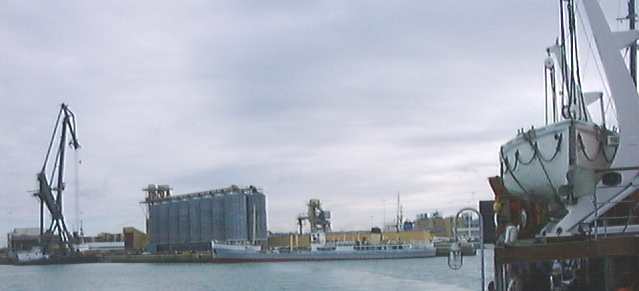
<!--#easybanner-->
Return to the South
Words and Pictures by Martin Longhurst
At the conclusion of her Clyde season on Sunday 1 September, Waverley set sail from Anderston Quay, Glasgow, initially for Belfast to take an evening charter on Monday. This had originally been planned to take place in June but was postponed owing to bad weather. Thereafter she left Northern Ireland at 23.00 for Weymouth, arriving at 07.00 on Wednesday after an excellent passage.
She then enjoyed two glorious days off service but, as in 2001, the weather deteriorated as soon as she entered service for an afternoon cruise from Weymouth. This took place as the wind rose and it was decided to cancel the evening cruise to Swanage, Bournemouth and Southampton, the paddler proceeding to Southampton light instead.
Saturday's schedule marked a change from previous years, with the Isle of Wight call changed from Sandown to Yarmouth and a consequent earlier start from Southampton at 10.00.

Waverley's berth is between the floating crane and Shieldhall's bow
Waverley sailed promptly, leaving her Cyldebuilt sister Shieldhall at the adjacent berth. Under blue skies and a light westerly wind, conditions were ideal.
Entering Portsmouth Harbour an unexpected finding was a floating crane moored adjacent to the Station Pier, inconveniently creating an obstacle to a direct approach to the Pier. Captain Colledge faced an immediate
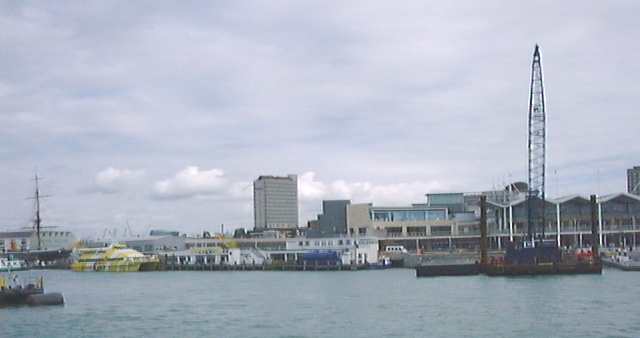
Station Pier, with FastCat Ryde alongside, flanked to the south by the floating crane and to the north by the masts of HMS Warrior, the Royal Navy's first ironclad warship.
difficulty, as without assistance from a tug, he had nowhere to go and little searoom to manoeuvre. The paddler went astern and ahead across the harbour a couple of times, turning round to allow an astern approach to the Pier. By this time the Blue Launch Peter James had been summoned to assist and this allowed the steamer to come alongside the Pier witout further difficulty.
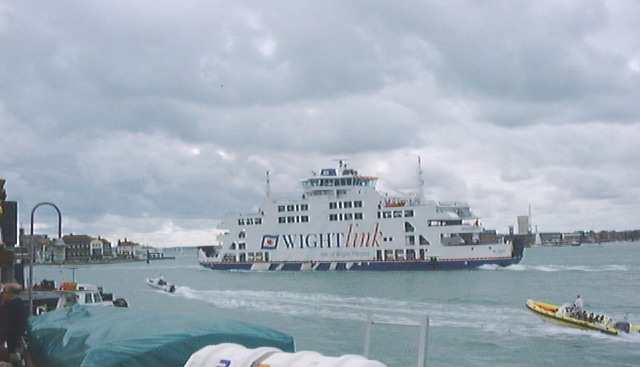
Wightlink's largest car ferry St Clare heads for her Gunwharf Terminal berth
A large exchange of passengers was made and the steamer sailed for Yarmouth with 580 aboard. By now a delay of 30 minutes had been incurred. The exit from Portsmouth Harbour was made more easily than the entrance. Nevertheless, some launch assistance was needed to get between the crane and a moored Fast Cat.
An hour and ten minutes took us to the Island port where another large exchange of passengers was made, but we sailed on with only 20 less. Before departure, Purser Jim McFadzean announced that, owing to increasing wind, it might not be possible to complete the Round the Island sailing.
 |
Fortunately, on reaching the Needles the pessimism proved unfounded and the steamer was able to continue via St Catherine's Point. Some time had been regained on the return to Yarmouth, but yet again the ship's popularity caused a lengthy call to allow for the passenger transfer. Yarmouth Pier is particularly narrow and this restricts the speed of this operation considerably. |
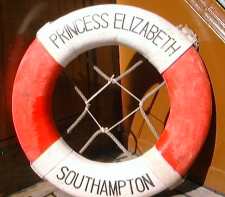 |
The cruise commemorated the 75th Anniversary of Red Funnel's P.S. Princess Elizabeth. During the voyage some members of her crew got together. |
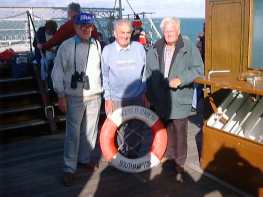 |
On arrival back at Portsmouth the gap had been further reduced by a moored car ferry. However, Captain Colledge threaded the steamer round the crane, past the car ferry and into position to go astern on to the corner of the Pier. With the stern rope landed, the launch Peter James pushed the bow alongside, completing this complicated approach without apparent difficulties.

To port two Wightlink ferries were moored to the "Odds & Evens" pontoon
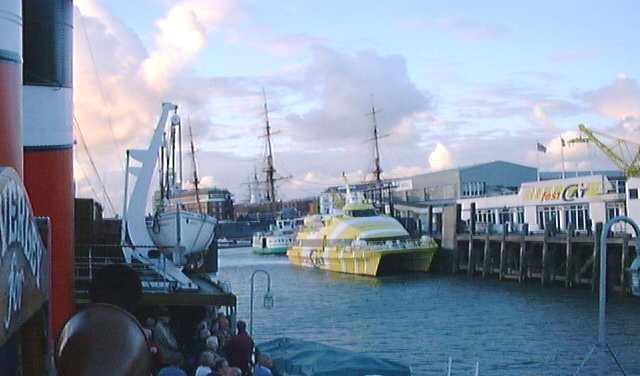
To starboard FastCat Ryde at Berth 1 with a Gosport ferry astern of her

Now moored at the Pier, the proximity of the floating crane, engaged on piling for Portsmouth's Millennium Tower, to the paddler's stern can clearly be seen
The steamer left the Pier in the conventional manner (i.e. to the north), again using launch assistance to line up with the harbour mouth. A swift run to Southampton ensued with arrival only 15 minutes late, despite the large numbers carried and the day's difficulties.
Sunday's sail from Southampton to Yarmouth, Bournemouth, Swanage and Weymouth went ahead in very clear conditions, both the St Catherine's Point on the Isle of Wight and Portland Bill being visible as we steamed passed St Alban's Head.
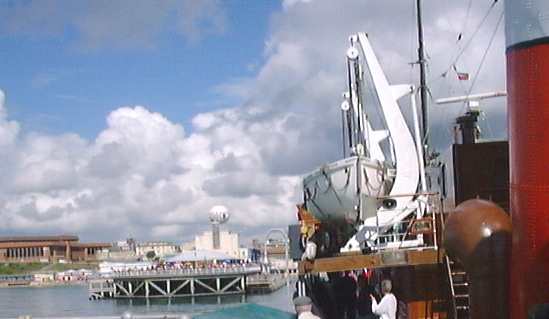
Coming into Bournemouth Pier as the Balloon goes up!
There were two rival attractions in Swanage, which may have reduced the popularity of the afternoon cruise to Weymouth. Firstly there was the Folk Featival with performers singing and dancing all round the town. By constrast, the second event was the arrival of the first through train to Swanage from the main line since closure in 1972. Even more remarkably, the train was one of Virgin's Voyagers which had come to be named Dorset Voyager. For more details see the Swanage Railway web site.
| Chief Engineer Ken Henderson checks the fuel flow shown by gauges in the refuelling station concealed in the aft funnel |  |
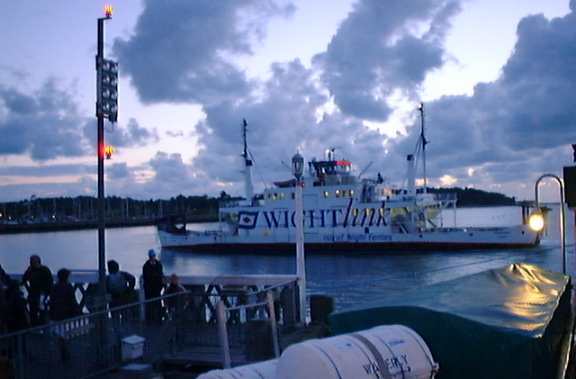 |
Dusk at Yarmouth on the return passage with Cenwulf heading for the Harbour |
Excellent time was kept throughout the day, with both the outward arrival at Weymouth and the return to Southampton being achieved 10 minutes early.
Remember that there is no public sailing on Saturday September 14 as the paddler will be on charter to the National Trust for a day and an evening cruise out of Portsmouth.